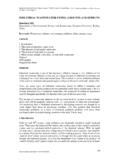Transcription of Mathematical Programming: An Overview 1
1 Mathematical Programming: An Overview1 Management science is characterized by a scientific approach to managerial decision making. It attemptsto apply Mathematical methods and the capabilities of modern computers to the difficult and unstructuredproblems confronting modern managers. It is a young and novel discipline. Although its roots can betraced back to problems posed by early civilizations, it was not until World War II that it became identifiedas a respectable and well defined body of knowledge. Since then, it has grown at an impressive pace,unprecedented for most scientific accomplishments; it is changing our attitudes toward decision-making, andinfiltrating every conceivable area of application, covering a wide variety of business, industrial, military, andpublic-sector science has been known by a variety of other names.
2 In the United States,operationsresearchhas served as a synonym and it is used widely today, while in Britainoperational researchseemsto be the more accepted name. Some people tend to identify the scientific approach to managerial problem -solving under such other names as systems analysis, cost benefit analysis, and cost-effectiveness will adhere tomanagement sciencethroughout this programming, and especially linear programming, is one of the best developed and mostused branches of management science. It concerns the optimum allocation of limited resources amongcompeting activities, under a set of constraints imposed by the nature of the problem being studied.
3 Theseconstraints could reflect financial, technological, marketing, organizational, or many other considerations. Inbroad terms, Mathematical programming can be defined as a Mathematical representation aimed at program-ming or planning the best possible allocation of scarce resources. When the Mathematical representation useslinear functions exclusively, we have a linear-programming 1947, George B. Dantzig, then part of a research group of the Air Force known as Project SCOOP(Scientific Computation Of Optimum Programs), developed thesimplex methodfor solving the generallinear-programming problem . The extraordinary computational efficiency and robustness of the simplexmethod, together with the availability of high-speed digital computers, have made linear programming themost powerful optimization method ever designed and the most widely applied in the business then, many additional techniques have been developed, which relax the assumptions of the linear-programming model and broaden the applications of the Mathematical -programming approach.
4 It is thisspectrum of techniques and their effective implementation in practice that are considered in this AN INTRODUCTION TO MANAGEMENT SCIENCES ince Mathematical programming is only a tool of the broad discipline known as management science,let us first attempt to understand the management-science approach and identify the role of mathematicalprogramming within that Programming: An is hard to give a noncontroversial definition of management science. As we have indicated before,this is a rather new field that is renewing itself and changing constantly. It has benefited from contributionsoriginating in the social and natural sciences, econometrics, and mathematics, much of which escape therigidity of a definition.
5 Nonetheless it is possible to provide a general statement about the basic elements ofthe management-science science is characterized by the use ofmathematical modelsin providing guidelines tomanagers for making effective decisions within the state of the current information, or in seeking furtherinformation if current knowledge is insufficient to reach a proper are several elements of this statement that are deserving of emphasis. First, the essence of manage-ment science is the model-building approach that is, an attempt to capture the most significant features of thedecision under consideration by means of a Mathematical abstraction.
6 Models are simplified representationsof the real world. In order for models to be useful in supporting management decisions, they have to be simpleto understand and easy to use. At the same time, they have to provide a complete and realistic representationof the decision environment by incorporating all the elements required to characterize the essence of theproblem under study. This is not an easy task but, if done properly, it will supply managers with a formidabletool to be used in complex decision , through this model-design effort, management science tries to provide guidelines to managers or,in other words, to increase managers understanding of the consequences of their actions.
7 There is never anattempt to replace or substitute for managers, but rather the aim is tosupportmanagement actions. It is critical,then, to recognize the strong interaction required between managers and models. Models can expedientlyand effectively account for the many interrelationships that might be present among the alternatives beingconsidered, and can explicitly evaluate the economic consequences of the actions available to managers withinthe constraints imposed by the existing resources and the demands placed upon the use of those , on the other hand, should formulate the basic questions to be addressed by the model, and theninterpret the model s results in light of their own experience and intuition.
8 Recognizing the model s complementarity between the superior computational capabilities provided by the model and the higherjudgmental capabilities of the human decision-maker is the key to a successful management-science , it is the complexity of the decision under study, and not the tool being used to investigate thedecision-making process, that should determine the amount of information needed to handle that decisioneffectively. Models have been criticized for creating unreasonable requirements for information. In fact,this is not necessary. Quite to the contrary, models can be constructed within the current state of availableinformation and they can be used to evaluate whether or not it is economically desirable to gather subject of proper model design and implementation will be covered in detail in Chapter MODEL CLASSIFICATIONThe management-science literature includes several approaches to classifying models.
9 We will begin with acategorization that identifies broad types of models according to the degree of realism that they achieve inrepresenting a given problem . The model categories can be illustrated as shown in Fig. ExerciseThe first model type is anoperational exercise. This modeling approach operates directly with the realenvironment in which the decision under study is going to take place. The modeling effort merely involvesdesigning a set of experiments to be conducted in that environment, and measuring and interpreting the resultsof those experiments. Suppose, for instance, that we would like to determine what mix of several crude oilsshould be blended in a given oil refinery to satisfy, in the most effective way, the market requirements forfinal products to be delivered from that refinery.
10 If we were to conduct an operational exercise to support thatdecision, we would try different quantities of several combinations of crude oil types directly in the Classification3refinery process, and observe the resulting revenues and costs associated with each alternative mix. Afterperforming quite a few trials, we would begin to develop an understanding of the relationship between theFig. of model oil input and the net revenue obtained from the refinery process, which would guide us in identifyingan appropriate order for this approach to operate successfully, it is mandatory to design experiments to be conductedcarefully, to evaluate the experimental results in light of errors that can be introduced by measurement inac-curacies, and to draw inferences about the decisions reached, based upon the limited number of observationsperformed.
















